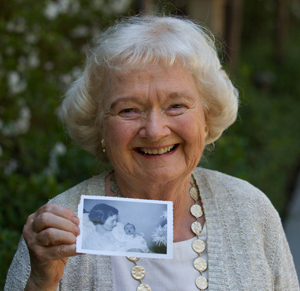December 21, 2011
The 'good old hospital' gets prepped for the next generation

When Mary Anne Simpson had her first baby in 1954, birth was considered the province of the doctor, who told her to "go home and knit."
Eighty years ago, Palo Alto Hospital opened its doors to its first patients and soon became a major care provider for the growing communities on the Peninsula.
Many local women today look back fondly on the "good old hospital," now known as the Hoover Pavilion, where they experienced some of the most miraculous moments of their lives.
"I thought it was great," said Joyce Israel, 78, who delivered her three children there in the 1950s. Visiting hours were limited, and stays could be a week or more, so she passed the time socializing with the other new mothers who shared her five-bed room. "We all sat there and chatted and had a gay old time. The babies were all brought in at the same time and were taken away at the same time, and we'd get back to chatting. I would have been bored as hell in a room all by myself."
Israel savored the daily back rubs from her nurse, a valuable comfort at a time when pain care in obstetrics was still evolving. The epidural was introduced in the early 1940s, and many women were still fearful of the new anesthetic procedure.
The way things were
Some, like Betty Ledoyen, opted for complete anesthesia that made her miss not only her baby's birth but much of what happened afterward as well.
"When I woke up the next morning I didn't know where I was," recalled Ledoyen, who delivered her first baby in 1947. "I looked around and there was a lady in the bed next to me. I said, 'Do you know if I had my baby? Was it a boy or girl?' She told me, 'It was a little girl.' I asked her if anyone had come to visit, and she said yes, a few people had come and gone."
Mary Anne Simpson was a new Stanford graduate when she gave birth to her first child at the hospital in 1954. Simpson took it upon herself to learn everything she could about nutrition, stages of labor, methods for relaxation and childbirth without pain medication.
"My doctor didn't like me asking questions. He shouted, 'Having a baby is not an intellectual project. My prescription for you is to go home and knit.'"
Geri Stewart, now 91, recalled paying a small fee when she was admitted to the hospital in December 1945. A week later, on Christmas Eve, she and her husband were preparing to bring their new baby boy home. "We did not have health insurance then at all. Nobody did," Stewart said. "And you could not leave the hospital until you paid your bill. My husband wrote a check for $125. Back then that was about a week's salary."
New perspectives
The first chief resident in obstetrics and gynecology at the hospital was Davis Baldwin, MD, who traveled to the hospital from San Francisco, where Stanford's School of Medicine was located until 1959. He remembers the old Palo Alto facility, then owned by the city, as "a unique little suburban hospital."
His new position was just one marker of a major turning point for community medical care: Stanford University had confirmed its plan to move the medical school's clinical program to the Palo Alto campus. Times were about to change, and so was obstetrical care.
The innovative care that Baldwin helped usher in was dramatically different from traditional obstetrics. "For starters, I let the husbands stay in the room," said Baldwin, who believed that separating couples at this important moment in their lives was "inhuman."
"People who wanted to be together couldn't be," he said. "Husbands were made to wait in the hallway by the elevators, an area we called the heir-port."
Baldwin-and the academic care teams that followed him-brought many medical innovations but never let go of the emphasis on the family experience. "I was always trying to look for ways to make things better for families," Baldwin said. "I tried to make the experience as pleasant and rewarding as it could be, so parents could say, 'That was the most extraordinary experience of my life.' And the beneficiary of that was the baby."
While Stanford University Medical Center continues to grow and evolve, that philosophy of keeping patients and families at the center of care delivery remains a core value of the hospitals today.
To view video interviews of people featured in this article or to learn more about the Medical Center Renewal Project, visit the project's website at SUMCRenewal.org.
A new role for Hoover Pavilion

Hoover Pavilion, the original Palo Alto Hospital, is being renovated to accommodate modern medicine. Once completed, the improved facility will house community physicians and Stanford Hospital clinics. It will also serve as the new home of the Stanford Health Library.
Through the restoration and reuse of the historic 1931 facade and building, the project reflects the landmark structure's legacy of caring at Stanford and solidifies its future as part of the next generation of medicine.
The Hoover Pavilion is being integrated into the surrounding site through extensive landscaping and gardens; the construction of a new parking garage for employees, patients and staff; and the flexibility to expand the campus with a new medical office building on the northwest portion of the site.
Site preparation and internal construction for the modernization project was launched in August. The renovated Hoover Pavilion is scheduled to be completed in October 2012, and the new parking structure is scheduled to be completed in summer 2013.
About Stanford Medicine
Stanford Medicine is an integrated academic health system comprising the Stanford School of Medicine and adult and pediatric health care delivery systems. Together, they harness the full potential of biomedicine through collaborative research, education and clinical care for patients. For more information, please visit med.stanford.edu.